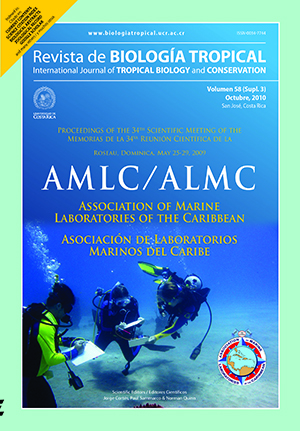Resumen
El sitio CARICOMP en Puerto Morelos, México, se monitoreo de 1993 a 2005. No se registraron cambios significativos en la temperatura del aire, los patrones de viento, la periodicidad y cantidad de lluvia, la temperatura superficial del mar y la transparencia del agua entre los años de muestreo. Durante el estudio se registraron cuatro huracanes menores. En el sitio del arrecife coralino la cobertura global promedio de algas carnosas (47%) y de algas tipo tapete (36%) fue elevada, mientras que la cobertura de corales (2%), esponjas (3%) y la abundancia de erizos (0.04 m-2) fue consistentemente baja. Los gorgonáceos fueron dominantes y mostraron cambios en su estructura comunitaria; el número de especies aumentó de 1993 a 1995, su abundancia disminuyó después del Huracán Roxanne (1995) y se recuperó en el 2001. En cuatro estaciones de pastos marinos la biomasa total de la comunidad permaneció constante (707.1-929.6 gps m-2) pero la biomasa sobre el sustrato del pasto Syringodium filiforme y de algas carnosas aumentó gradualmente. La biomasa total (531-699 gps m-2) y productividad de hojas (0.89-1.56 gps m-2 d-1) del pasto Thalassia testudinum permaneció constante, pero la especie invirtió proporcionalmente más biomasa en el tejido de hojas sobre el sustrato al final del estudio. Los huracanes menores entre 1993 y 2005 no produjeron impactos detectables en las camas de pastos, sin embargo, el huracán mayor Wilma (Octubre 2005) cambió la composición de la comunidad en tres estaciones y causó el enterramiento completo de la vegetación en la estación costera. El cambio gradual en las comunidades de pastos marinos y arrecife registrado en 12 años de monitoreo continuo en el sitio CARICOMP puede reflejar un aumento en la contaminación causada por el rápido incremento en desarrollo urbano y turístico a lo largo de la costa y tierra adentro de Puerto Morelos, acompañado por malas prácticas de manejo del agua.##plugins.facebook.comentarios##

Esta obra está bajo una licencia internacional Creative Commons Atribución 4.0.
Derechos de autor 2010 Revista de Biología Tropical
Descargas
Los datos de descargas todavía no están disponibles.






